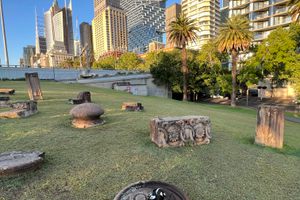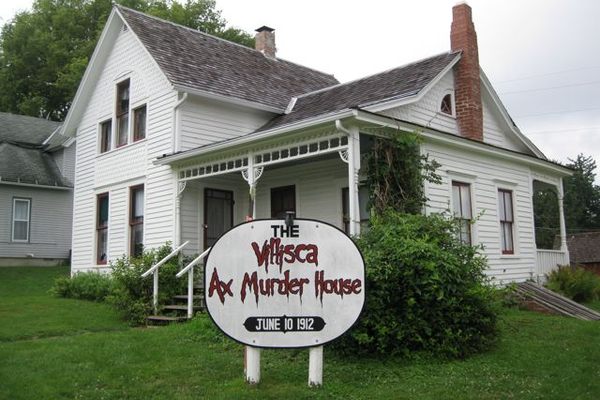About
At the edge of one of Sydney’s most sun-drenched tourist hotspots, the ferry port of Circular Quay, a handsome yet unassuming building lures curious visitors away from busking circus refuse and the constant stream of didgeridoo techno to reveal the darker side of the city’s past. Past the spiked iron gates and through the sandstone-block archways lurk traces of Sydney and New South Wales’ seedy underbelly of crime, violence, and gangsters from the mid-nineteenth century onwards.
Founded in 1991, the Justice and Police Museum is housed in the complex that served as Sydney’s Water Police Station and a magistrates court between 1856 and 1886, and retains its late-Victorian features, down to the foreboding police charge room and grim remand cells.
If there are ghosts lurking within these walls, they are likely not the friendly variety. Certainly you will feel their eyes on you in the Rogues’ Gallery from the City of Shadows exhibition: black-and-white mug shots drawn in part from the mysterious "Special Photographs" section of the police archives of 1912-1930, in which many perpetrators and persons of interest can no longer be identified today. The exhibition reveals that the Australian mug shots from this period are distinctive in law enforcement of the era, with the subjects seemingly permitted to adopt a pose of their choice. For many of the small-time crooks and con artists pictured — some staring back at us with deranged, empty gazes as the cocaine and morphine craze took hold in the 1920s; some surprisingly insouciant or playing up to the camera with a touch of bravado; some looking really rather dapper — this could well have been the only time their photo was taken. The result is a haunting series of character portraits. The museum’s crime scene images are still more unsettling, whether a victim is pictured, the gory details exposed on a bloodstained rug, or some grimy interior sits eerily empty, unanswered questions hanging in the air.
The criminals who are known to researchers and whose artifacts are on display range from notorious bushrangers of New South Wales – among them Captain Moonlite, a precursor to Ned Kelly – to bootleggers known as "sly groggers" to old-world urban crime lords. Most surprising are the women who dominated this sordid scene, none more ruthlessly than Kate Leigh (1881-1964). This stout, middle-aged lady was no seductive femme fatale, but became the most powerful "vice queen" of the 1920s and 30s with an empire of illegal liquor and stolen goods and a penchant for shocking violence, the members of her gang wielding cutthroat razors as standard issue (several of which are held at the museum).
Other women encountered in these corridors committed heinous crimes on a domestic level. The sweet, neighbourly granny Caroline Grills laced her irresistible baked goods with rat poison before offering them to her family and friends; see the bottle of Thall-Rat in the display cabinet. In 1889, Louisa Collins ("The Borgia of Botany") became the last woman to be hanged in New South Wales after poisoning two unsatisfactory husbands in succession; an execution hood sets this scene. Women crop up as victims, too, such as the "Pyjama Girl," a young woman found burned up in a ditch in 1934 with nothing to identify her but her exotic yellow silk jammies. Then there is Linda Agostini’s death mask and the photos of her face with its gaping, bloody bullet-wound make for a chilling contrast with the serene expression of the blonde in the reconstructed police sketch. The zinc bath in which her body had been stored and publicly exhibited for identification purposes is also among the artifacts from this case. And who could forget the falsely convicted Lindy Chamberlain and her quintessentially Australian "a dingo ate my baby" defense? She crops up here too.
Speaking of dogs, the museum has two behind glass. Tess, an Alsatian, was the first to perform official duties as part of the Police Dog Unit formed in 1932. She died after ten years of loyal service and was preserved by taxidermists at the Australian Museum before being transferred here. The second is a wimpy little Pekinese named Cherry, perhaps an inferior specimen but with no less impressive a story, playing a key role in the unraveling of Australia’s first child abduction and murder. In the Graeme Thorne case of 1960, hairs on the rug wrapped around the eight-year-old’s corpse were matched to Cherry’s tawny coat, helping to convict dog-owner Stephen Bradley, who had fled the country and abandoned his pet in a kennel. Cherry was hit by a car during the trial (an accident?) but NSW police sent his body to a taxidermist and admitted him as evidence. Good boy.
Down the hall you will find an intimidating arsenal of pistols, daggers, and axes seized as evidence; imposing knuckledusters and maces confiscated, alarmingly, by the Railway Police.
It’s hard to imagine someone waiting for the train at Redfern station with a homemade medieval mace in their coat pocket since the suburbs where notorious thugs and gangsters darkened every door are now some of Sydney’s trendiest.
Emerging from the museum into the sun don't forget that you never know who could be lurking in the next laneway.
Related Tags
Community Contributors
Added By
Published
January 8, 2015
































